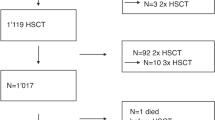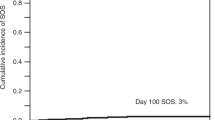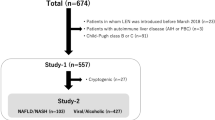Abstract
Chronic GVHD (cGVHD) of the liver is an important cause of morbidity and mortality after allogeneic hematopoietic stem cell transplantation (allo-SCT). It is characterized by the destruction of bile duct epithelium followed by progressive cholestasis, which resembles primary biliary cirrhosis (PBC) clinically and histologically. Bezafibrate (BF) is a widely used agent for hyperlipidemia that is also effective in ursodeoxycholic acid (UDCA)-resistant PBC patients. The putative mechanism in cholestasis is that BF upregulates the expression of phosphatidylcholine flippase on bile canaliculi, facilitates phospholipid output into bile and relieves bile duct damage caused by hydrophobic bile salts. Therefore, the effects of BF in patients with cGVHD of the liver were investigated. Of 87 patients with cGVHD who survived more than 100 days after SCT, 8 were given BF to treat liver cGVHD because of a poor therapeutic response to UDCA and immunosuppressants. The serum alkaline phosphatase (ALP) and γ-glutamyl transpeptidase (γ-GTP) levels decreased significantly within 1 month after initiation of BF therapy compared with those before BF therapy in all patients (ALP, 964.9.0±306.9 to 597.8±102.5 IU/l, P=0.012; γ-GTP, 528.8±299.0 to 269.0±119.9 IU/l, P=0.012). BF was effective in patients with liver cGVHD, including UDCA-resistant patients. BF could be a novel therapeutic option for liver cGVHD that helps to preserve normal immunity with the antileukemic effect of cGVHD.
This is a preview of subscription content, access via your institution
Access options
Subscribe to this journal
Receive 12 print issues and online access
$259.00 per year
only $21.58 per issue
Buy this article
- Purchase on Springer Link
- Instant access to full article PDF
Prices may be subject to local taxes which are calculated during checkout



Similar content being viewed by others
References
Socié G, Stone JV, Wingard JR, Weisdorf D, Henslee-Downey PJ, Bredeson C et al. Long-term survival and late deaths after allogeneic bone marrow transplantation. Late Effects Working Committee of the International Bone Marrow Transplant Registry. N Engl J Med 1999; 341: 14–21.
Lee SJ, Vogelsang G, Flowers ME . Chronic graft-versus-host disease. Biol Blood Marrow Transplant 2003; 9: 215–233.
Gilman AL, Serody J . Diagnosis and treatment of chronic graft-versus-host disease. Semin Hematol 2006; 43: 70–80.
Vogelsang GB . How I treat chronic graft-versus-host disease. Blood 2001; 97: 1196–1201.
Quaglia A, Duarte R, Patch D, Ngianga-Bakwin K, Dhillon AP . Histopathology of graft versus host disease of the liver. Histopathology 2007; 50: 727–738.
Fipovich AH, Weisdorf D, Pavletic S, Socie G, Wingard JR, Lee SJ et al. National Institutes of Health consensus development project on criteria for clinical trials in chronic graft-versus host disease: I. Diagnosis and staging working group report. Biol Blood Marrow Transplant 2005; 11: 945–956.
Wakae T, Takatsuka H, Seto Y, Iwata N, Mori A, Okada M et al. Similarity between hepatic graft-versus-host disease and primary biliary cirrhosis. Hematology 2002; 7: 305–310.
Quaranta S, Shulman H, Ahmed A, Shoenfeld Y, Peter J, McDonald GB et al. Autoantibodies in human chronic graft-versus-host disease after hematopoietic cell transplantation. Clin Immunol 1999; 91: 106–116.
Idilman R, Erden E, Arat M, Soydan E, Erkan O, Kuzu I et al. Trefoil factor expression in biliary epithelium of graft-versus-host disease of the liver after allogeneic hematopoietic cell transplantation. Transplantation 2005; 80: 1099–1104.
Shi J, Wu C, Lin Y, Chen YX, Zhu L, Xie WF . Long-term effects of mid-dose ursodeoxycholic acid in primary biliary cirrhosis: a meta-analysis of randomized controlled trials. Am J Gastroenterol 2006; 101: 1529–1538.
Ruutu T, Eriksson B, Remes K, Juvonen E, Volin L, Remberger M et al. Ursodeoxycholic acid for the prevention of hepatic complications in allogeneic stem cell transplantation. Blood 2002; 100: 1977–1983.
Iwasaki S, Akisawa N, Saibara T, Onishi S . Fibrate for treatment of primary biliary cirrhosis. Hepatol Res 2007; 37 (Suppl 3): S515–S517.
Iwasaki S, Ohira H, Nishiguchi S, Zeniya M, Kaneko S, Onji M et al. The efficacy of ursodeoxycholic acid and bezafibrate combination therapy for primary biliary cirrhosis: a prospective, multicenter study. Hepatol Res 2008; 38: 557–564.
Iwasaki S, Tsuda K, Ueta H, Aono R, Ono M, Saibara T et al. Bezafibrate may have a beneficial effect in pre-cirrhotic primary biliary cirrhosis. Hepatol Res 1999; 16: 12–18.
Nakai S, Masaki T, Kurokohchi K, Deguchi A, Nishioka M . Combination therapy of bezafibrate and ursodeoxycholic acid in primary biliary cirrhosis: a preliminary study. Am J Gastroenterol 2000; 95: 326–327.
Kaplan MM, Gershwin ME . Primary biliary cirrhosis. N Engl J Med 2005; 353: 1261–1273.
Moffit JS, Aleksunes LM, Maher JM, Scheffer GL, Klaassen CD, Manautou JE . Induction of hepatic transporters multidrug resistance-associated proteins (Mrp) 3 and 4 by clofibrate is regulated by peroxisome proliferator-activated receptor alpha. J Pharmacol Exp Ther 2006; 317: 537–545.
De Vree JM, Ottenhoff R, Bosma PJ, Smith AJ, Aten J, Oude Elferink RP . Correction of liver disease by hepatocyte transplantation in a mouse model of progressive familial intrahepatic cholestasis. Gastroenterology 2000; 119: 1720–1730.
Kita R, Takamatsu S, Kimura T, Kokuryu H, Osaki Y, Tomono N . Bezafibrate may attenuate biliary damage associated with chronic liver diseases accompanied by high serum biliary enzyme levels. J Gastroenterol 2006; 41: 686–692.
Acknowledgements
This work was supported in part by Grants-in-Aid for Scientific Research from the Japanese Ministry of Education, Culture, Sport, Science and Technology, and for Cancer Research from the Japanese Ministry of Health, Labor and Welfare.
Author information
Authors and Affiliations
Corresponding author
Ethics declarations
Competing interests
The authors declare no conflict of interest.
Rights and permissions
About this article
Cite this article
Hidaka, M., Iwasaki, S., Matsui, T. et al. Efficacy of bezafibrate for chronic GVHD of the liver after allogeneic hematopoietic stem cell transplantation. Bone Marrow Transplant 45, 912–918 (2010). https://doi.org/10.1038/bmt.2009.251
Received:
Revised:
Accepted:
Published:
Issue Date:
DOI: https://doi.org/10.1038/bmt.2009.251
Keywords
This article is cited by
-
Prophylactic and therapeutic treatment of graft-versus-host disease in Japan
International Journal of Hematology (2015)



